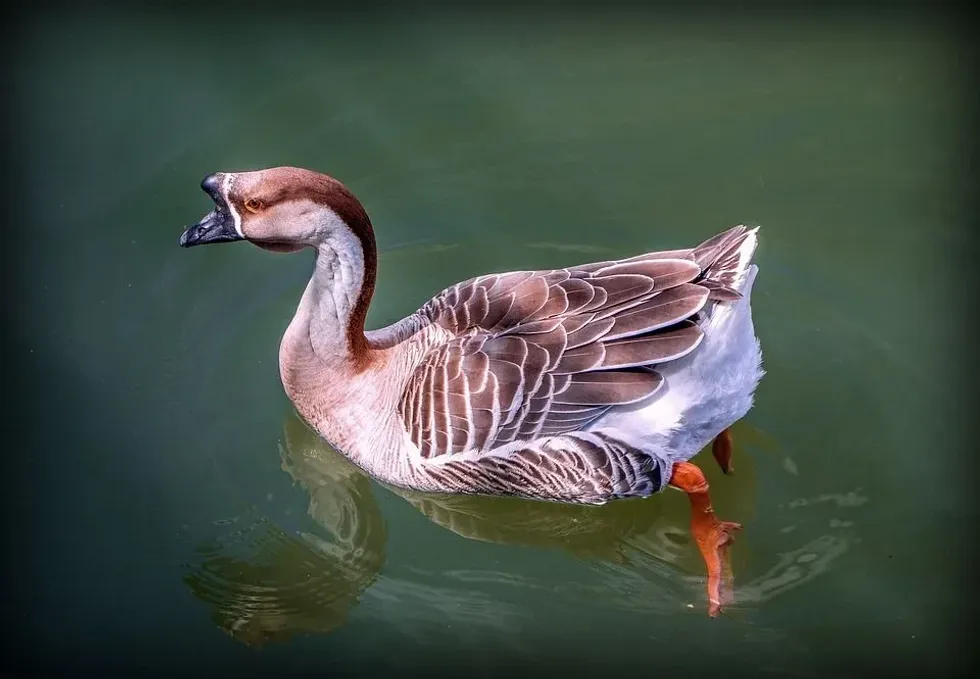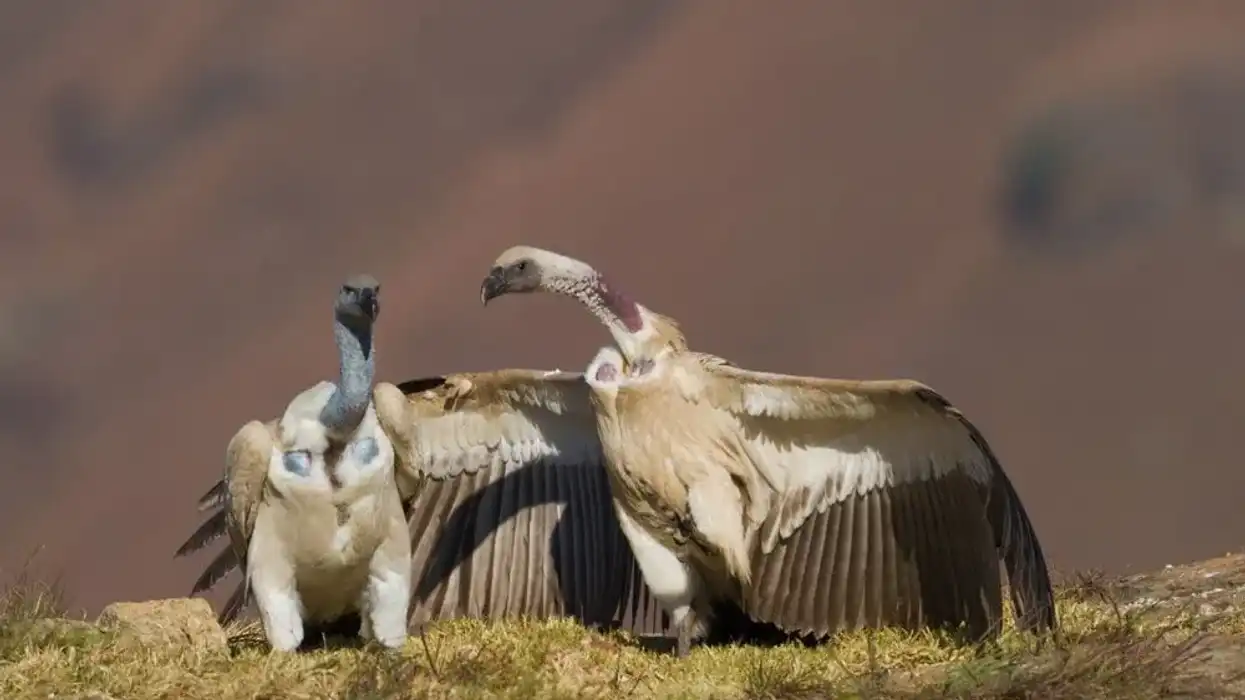If you are looking for a unique breed of goose, then you should look no further than the African goose. While they are known as the African geese, these birds are more related to the Chinese geese, although that origin is disputed.
What can be agreed upon is that the African breed descends from the wild swan goose from Asia. Their origin is a mystery as these geese arrived on North American soil through ships that would visit the continent.
There are two varieties of African geese found in North America. They are gray or brown African geese and white African geese. For the brown and gray African geese, mature geese have a dark brown stripe from the back of their head to their neck.
The bill and knob on the top of their forehead are usually black. The white African geese have entirely white plumage, along with an orange knob and bill.
Read on to learn more about these African geese. For info on other avian breeds, take a look at snow goose facts and nene goose facts.
African Goose Interesting Facts
What type of animal is an African goose?
The African goose is a type of goose derived from the swan goose and the Chinese goose. African geese, despite their name, are thought to have originated in China.
What class of animal does an African goose belong to?
African geese belong to the class of Aves or birds. However, interestingly there is very little detail on the scientific classification of the African geese.
How many African geese are there in the world?
Unfortunately, there are no official records that state the exact number of African geese in the world. However, what contributes to their high number is the fact that the African geese are one of the breeds that are used for poultry being admitted to the American Poultry Association's Standard of Perfection way back in 1874.
Where does an African goose live?
While no one knows the origin and from whom they descend, the African goose arrived in North America on boats and ships. Since then, they have spread to other parts of the world including Europe and South America.
What is an African goose's habitat?
While this species of goose is thought to have come from Chinese geese, the natural habitat range of the African geese isn't quite clear. They mostly live near lakes, ponds, or water bodies that have a thick vegetation cover around them.
Mostly used as one of the domestic breeds, they are often seen roaming around and exploring. Despite being considered a docile bird, there have been cases where the male can become aggressive if disturbed.
Who do African geese live with?
Like other breeds of geese, African geese can be found in flocks and groups. Additionally, African geese are spotted to be most comfortable when living in groups of two or three.
How long does an African goose live?
The African goose has an average lifespan of around 10 to 15 years. However, don't be surprised if your African goose lives longer. This is one of the breeds that are considered to be long-lived and have been observed to live for 25 years with proper care.
How do they reproduce?
The reproduction of the African goose takes place like other breeds. Females are known to lay around 20 eggs per year, but that number may rise to 40.
This is far fewer than other breeds like the Chinese geese who lay more than 50 to 200 eggs per year. The eggs are incubated for 30 days, after which they hatch. Young females can produce eggs in their very first year if they are well-cared for.
What is their conservation status?
Being a breed of domesticated goose, the African goose is not listed by the IUCN or the International Union For Conservation Of Nature on their conservation Red List. This long-lived variety of goose is bred commercially for poultry and also kept for recreational purposes.
However, in the poultry industry, many breeders cross-breed the African geese with the Toulouse geese to get commercially successful hybrid meat. This practice reduces the number of pure-bred African geese.
African Goose Fun Facts
What do African geese look like?

The most distinct feature of the African geese is their size. They are big birds with thick necks and self-confident postures accompanied by their strong bill.
In terms of physical appearance, mature African geese are recognized by the large knob on their head, specifically on their head. Even though they are well accustomed to cold weather, the knobs may get frostbite in harsh winters.
The thick neck region of African geese also has a crescent-shaped dewlap that is situated between the lower jaw and the upper neck. They have a neatly folded tail that is pointed upward. They do not have fatty lobes on their smooth and round abdomen.
This breed of bird does not have any keels. The coloration may differ from gray to brown to white.
How cute are they?
With its inquisitive and docile nature, some may find this large bird to be cute.
How do they communicate?
African geese are loud and vocal birds who communicate via sounds that can be perceived to be more as a 'doin', rather than the typical 'honk' of geese.
How big is an African goose?
African geese are quite big. They can grow up to a height of 3.2 ft. In comparison, an emu is twice their size.
How fast can an African goose fly?
As the African geese are keelless, they cannot fly.
How much does an African goose weigh?
The weight of African geese normally ranges between 16-26lb.
What are the male and female names of the species?
Males are called geese while females are called ganders.
What would you call a baby African goose?
Baby, or young, African geese are called goslings.
What do they eat?
Whether being raised as poultry or domesticated birds, the African geese feed on grasses and seeds. However, they need to have grit in their diet so that it helps them to digest their food.
Are they aggressive?
While these geese are docile, a male can be aggressive towards you. Females are only aggressive while protecting their young.
Would they make a good pet?
They are an integral part of American poultry, with a gander producing eggs from her very first year. They are easy to care for and can make great pets with their usually calm temperament. You can easily get them for USD 60 to USD 300.
Did you know...
For the African goose, it can take up to 36 months for the dewlap to develop.
What is the body temperature of an African Goose?
As they are not suited to harsh cold temperatures, we can assume that the African goose is warm-blooded.
Where did the African Goose originate from?
While the origin of the African goose is subject to a lot of debate, it is more or less thought that they share lineage with the Chinese goose from southeast China.
What causes the dropped tummy of the African Goose?
Aged ganders are known to have a drooping tummy during the breeding season; however, in general, you must avoid getting an African goose that has a dropped tummy as this may be a sign of infertility.
Here at Kidadl, we have carefully created lots of interesting family-friendly animal facts for everyone to discover! Learn more about some other birds including African pygmy goose facts or kelp goose facts.
You can even occupy yourself at home by coloring in one of our free printable African goose coloring pages.










